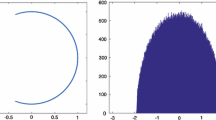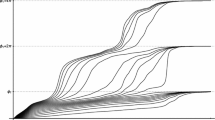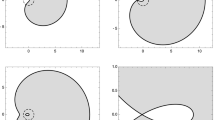Abstract
Motivated by quantum information theory, we introduce a dynamical random density matrix built out of the sum of \(k \ge 2\) independent unitary Brownian motions. In the large size limit, its spectral distribution equals, up to a normalising factor, that of the free Jacobi process associated with a single self-adjoint projection with trace 1/k. Using free stochastic calculus, we extend this equality to the radial part of the free average of k free unitary Brownian motions and to the free Jacobi process associated with two self-adjoint projections with trace 1/k, provided the initial distributions coincide. In the single projection case, we derive a binomial-type expansion of the moments of the free Jacobi process which extends to any \(k \ge 3\) the one derived in Demni et al. (Indiana Univ Math J 61:1351–1368, 2012) in the special case \(k=2\). Doing so give rise to a non normal (except for \(k=2\)) operator arising from the splitting of a self-adjoint projection into the convex sum of k unitary operators. This binomial expansion is then used to derive a pde satisfied by the moment generating function of this non normal operator and for which we determine the corresponding characteristic curves. As an application of our results, we compute the average purity and the entanglement entropy of the large-size limiting density matrix.
Similar content being viewed by others
Notes
We omit the dependence on k for sake of clarity.
The state \(\tau \) is tracial and all the processes are continuous in the strong topology.
References
Biane, P.: Free Brownian motion, free stochastic calculus and random matrices. In: Voiculescu D.V. (ed.) Free Probability Theory. Fields Institute Communications, vol. 12, pp. 1–19. American Mathematical Society, Providence (1997)
Biane, P., Speicher, R.: Stochastic calculus with respect to free Brownian motion and analysis on Wigner space. Probab. Theory Relat. Fields 112(3), 373–409 (1998)
Belinschi, S.T., Sniady, P., Speicher, R.: Eigenvalues of non-Hermitian random matrices and Brown measure of non-normal operators: Hermitian reduction and linearization method. Linear Algebra Appl. 537, 48–83 (2018)
Collins, B., Dahlqvist, A., Kemp, T.: The spectral edge of unitary Brownian motion. Probab. Theory Relat. Fields 170(1–2), 49–93 (2018)
Collins, B., Nechita, I.: Random matrix techniques in quantum information theory. J. Math. Phys. 571(015215), 34 (2016)
Zyczkowski, K., Penson, K.A., Nechita, I., Collins, B.: Generating random density matrices. J. Math. Phys. 52(6), 062201 (2011)
Demni, N.: Free Jacobi process. J. Theor. Probab. 21, 118–143 (2008)
Demni, N.: Distributions of truncations of the heat kernel on the complex projective space. Ann. Math. Blaise Pascal 21(2), 1–20 (2014)
Demni, N., Guay-paquet, M., Nica, A.: Star-cumulants of the free unitary Brownian motion. Adv. Appl. Math. 69, 1–45 (2015)
Demni, N., Hamdi, T.: Support of the Brown measure of the product of a free unitary Brownian motion by a free self-adjoint projection. J. Funct. Anal. 282(6), 109362 (2022)
Demni, N., Hamdi, T.: Relating moments of self-adjoint polynomials in two orthogonal projections. Available on arXiv
Demni, N., Hamdi, T., Hmidi, T.: Spectral distribution of the free Jacobi process. Indiana Univ. Math. J. 61, 1351–1368 (2012)
Erdelyi, A., Magnus, W., Oberhettinger, F., Tricomi, F. G.: Higher Transcendental Functions. Vol. I, Based, in Part, on Notes Left by Harry Bateman, xxvi+302. McGraw-Hill Book Co., Inc., New York (1953)
Hamdi, T.: Spectral distribution of the free Jacobi process, revisited. Anal. PDE 11(8), 2137–2148 (2018)
Hamdi, T.: Liberation, free mutual information and orbital free entropy. Nagoya Math. J. 239, 1–27 (2018)
Hamdi, T.: Free mutual information for two projections. Complex Anal. Oper. Theory 12(7), 1697–1705 (2018)
Haagerup, U., Larsen, F.: Brown’s spectral distribution measure for R-diagonal elements in finite von Neumann algebras. J. Funct. Anal. 176(2), 331–367 (2000)
Hiai, F., Petz, D.: The Semicircle Law, Free Random Variables, and Entropy. American Mathematical Society, Providence (2000)
Horzum, T., Kocer, E.G.: On some properties of Horadam polynomials. Int. Math. Forum. 4(25–28), 1243–1252 (2009)
Izumi, M., Ueda, Y.: Remarks on free mutual information and orbital free entropy. Nagoya Math. J. 220, 45–66 (2015)
Jarosz, A.: Summing free unitary random matrices. Phys. Rev. E 84, 011146 (2011)
Kukulski, R., Nechita, I., Pawela, L., Puchala, Z., Zyczkowski, K.: Generating random quantum channels. J. Math. Phys. 62(6), 062201 (2021)
Lévy, T.: Schur-Weyl duality and the heat kernel measure on the unitary group. Adv. Math. 218(2), 537–575 (2008)
Liao, M.: Lévy processes in Lie groups. In: Cambridge Tracts in Mathematics, vol. 162, x+266. Cambridge University Press, Cambridge (2004)
Manocha, H.L., Srivastava, H.M.: A treatise on generating functions. In: Ellis Horwood Series: Mathematics and its Applications (1984)
Mingo, J. A., Speicher, R.: FreMingo, J. A., Speicher, R.: Free probability and random matrices. Fields Institute Monographs, 35. Springer, New York; Fields Institute for Research in Mathematical Sciences, Toronto, ON, (2017)
Nechita, I., Pellegrini, C.: Random pure quantum states via unitary Brownian motion. Electron. Commun. Probab. 18(27), 13 (2013)
Nica, A., Speicher, R.: On the multiplication of free N -tuples of noncommutative random variables. Am. J. Math. 118(4), 799–837 (1996)
Nica, A., Speicher, R.: Lectures on the Combinatorics of Free Probability. London Mathematical Society Lecture Note Series, vol. 335 (2006)
Verdú, S.: Fifty years of Shannon theory. IEEE Trans. Inf. Theo. 44(6), 2057–2078 (1998)
Acknowledgements
The authors extend their appreciation to the Deputyship for Research & Innovation, Ministry of Education, Saudi Arabia for funding this research work through the project number (QU-IF-2-4-1-26574). The authors also thank to Qassim University for technical support.
Author information
Authors and Affiliations
Corresponding author
Ethics declarations
Conflict of interest
On behalf of all authors, the corresponding author states that there is no conflict of interest.
Additional information
Publisher's Note
Springer Nature remains neutral with regard to jurisdictional claims in published maps and institutional affiliations.
Appendices
Appendix A. Moments of stationary distribution
In this appendix, we derive another expression of
To the best of our best knowledge, formula (34) below never appeared in literature. Compared to (21), it has the merit to separate the case \(k=2\) corresponding to the arcsine distribution from other values \(k \ge 3\). Our main ingredients are two properties satisfied by the Gauss hypergeometric function.
To proceed, perform the variable change \(x = 4(k-1)y/k^2\) to write:
Here, the second equality follows from the Euler integral representation of the Gauss hypergeometric function, the third and fourth ones follow from the variational formula (25), p.102 and formula (6), p.101 in [13]. Using direct computations, we readily see that
for some polynomial of degree n. For instance
Consequently,
which reduces for \(k=2\) to the known formula:
Appendix B. Free cumulants of an orthogonal projection
The first part of the proof of (29) is a routine computation in free probability theory and we refer the reader to [18] for further details on this machinery. Start with the Cauchy transform of P:
Next, consider the equation
for y lying in a neighborhood of zero. Then the K-transform of P reads:
and in turn, its R-transform is given by
It remains to write down the Taylor expansion of the function:
To this end, we appeal to the generating series of Legendre polynomials:
Indeed, setting \(\beta := 1-2\alpha \in [-1,1]\), one has
so that
where the last equality follows from the recurrence relation:
Extracting the Taylor coefficients of \(f_{\alpha }\) and recalling the definition
we get (29).
Note that since Legendre polynomials are orthogonal with respect to the uniform distribution in \([-1,1]\), they are parity preserving. In particular,
so that one recovers (28) after some computations.
Rights and permissions
Springer Nature or its licensor (e.g. a society or other partner) holds exclusive rights to this article under a publishing agreement with the author(s) or other rightsholder(s); author self-archiving of the accepted manuscript version of this article is solely governed by the terms of such publishing agreement and applicable law.
About this article
Cite this article
Hamdi, T., Demni, N. Summing free unitary Brownian motions with applications to quantum information. Lett Math Phys 113, 80 (2023). https://doi.org/10.1007/s11005-023-01702-x
Received:
Revised:
Accepted:
Published:
DOI: https://doi.org/10.1007/s11005-023-01702-x




